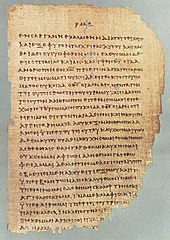নূতন নিয়ম
| নূতন নিয়মের পুস্তকসমূহ |
|---|
 |
| সুসমাচার |
| মথি · মার্ক · লুক · যোহন |
| প্রেরিতদের কার্য |
| প্রভু যীশুর প্রেরিত শিষ্যদের কার্যবিবরণী |
| পত্রাবলি |
|
রোমীয় ১ করিন্থীয় · ২ করিন্থীয় গালাতীয় · ইফিসীয় ফিলিপীয় · কলোসীয় ১ থিষলনিকীয় · ২ থিষলনিকীয় ১ তিমথি · ২ তিমথি তীত · ফিলিমন হিব্রু · যাকোব ১ পিতর · ২ পিতর ১ যোহন · ২ যোহন · ৩ যোহন যিহুদা |
| অ্যাপোক্যালিপস |
| প্রকাশিত বাক্য |
| নূতন নিয়ম পাণ্ডুলিপি |
| খ্রিস্টধর্ম |
|---|
| ধারাবাহিক নিবন্ধের অংশ |
 |
|
|
নূতন নিয়ম বা নতুন বাইবেল (ইংরেজি: New Testament) খ্রিস্টানদের ধর্মগ্রন্থ বাইবেলের শেষভাগ। ৪৫ থেকে ১৪০ খ্রিষ্টাব্দের মধ্যে একাধিক লেখক এটি রচনা করেন। এই বিভিন্ন লেখকের রচনা কয়েক শতাব্দী ধরে সংগৃহীত হয়ে একখণ্ড গ্রন্থের আকার ধারণ করে। নতুন বাইবেল খ্রিস্ট ধর্মের ভিত্তি। পাশ্চাত্যে গড়ে ওঠা সভ্যতা ও নৈতিকতা বোধের উপর ব্যাপক প্রভাব রয়েছে এই গ্রন্থের। [১]
নূতন নিয়ম হল খ্রিস্টীয় ধর্মগ্রন্থের একটি সংগ্রহ যা মূলত কোইন গ্ৰিক ভাষায় বিভিন্ন লেখক দ্বারা বিভিন্ন সময়ে লেখা। যদিও ওল্ড টেস্টামেন্ট ক্যানন বিভিন্ন খ্রিস্টীয় সম্প্রদায়ের মধ্যে কিছুটা পরিবর্তিত হয় , নিউ টেস্টামেন্টের ২৭টি-বই ক্যাননটি খ্রিস্টধর্মের মধ্যে প্রায় সর্বজনীনভাবে স্বীকৃত হয়েছে অন্তত শেষ প্রাচীনকাল থেকে । এইভাবে, আজ প্রায় সমস্ত খ্রিস্টীয় ঐতিহ্যে, নিউ টেস্টামেন্ট ২৭টি বই নিয়ে গঠিত:
- 4টি ক্যানোনীয় গসপেল ( ম্যাথিউ , মার্ক , লুক এবং জন )
- প্রেরিতদের কর্ম
- সাধু পলের ১৩টি পত্র
- হিব্রুদের পত্র
- ৭টি সাধারণ পত্র
- দ্য বুক অফ রিভিলেশন
২৭টি বইয়ের প্রথম পরিচিত সম্পূর্ণ তালিকা পাওয়া যায় আলেকজান্দ্রিয়ার ৪র্থ শতাব্দীর বিশপ অ্যাথানাসিয়াসের লেখা একটি চিঠিতে, যেটি ছিল ৩৬৭ খ্রিস্টাব্দে।[১] ২৭টি বই নিউ টেস্টামেন্ট প্রথম আনুষ্ঠানিকভাবে উত্তর আফ্রিকার হিপ্পো (৩৯৩ খ্রি.) এবং কার্থেজ (৩৯৭ খ্রি.) কাউন্সিলের সময় আনুষ্ঠানিকভাবে প্রচলিত হয়েছিল। পোপ ইনোসেন্ট আমি 405 সালে একই ক্যানন অনুমোদন করেছিলেন, তবে সম্ভবত ৩৮২ সালে রোমে একটি কাউন্সিল পোপ দামাসাস প্রথমের অধীনে একই তালিকা প্রথম দিয়েছিল। এই কাউন্সিলগুলি পুরাতন নিয়মের ক্যানন প্রদান করেছিল, যার মধ্যে অ্যাপোক্রিফাল বই অন্তর্ভুক্ত ছিল। [৩]
সর্বশেষ নূতন নিয়ম গ্ৰন্থটির রচনার তারিখের বিষয়ে কোন পণ্ডিতদের মতৈক্য নেই। রক্ষণশীল পণ্ডিত জন এ.টি রবিনসন , ড্যান ওয়ালেস এবং উইলিয়াম এফ অ্যালব্রাইট ৭০ খ্রিস্টাব্দের আগে নিউ টেস্টামেন্টের সমস্ত বইয়ের তারিখ দিয়েছেন। [৪] অন্যান্য অনেক পণ্ডিত, যেমন বার্ট ডি. এহরম্যান এবং স্টিফেন এল. হ্যারিস , এর থেকে অনেক পরে কিছু নিউ টেস্টামেন্ট গ্রন্থের তারিখ দিয়েছেন; [৫] [৬] [৭] রিচার্ড পারভো ডেট করেছেন লুক-অ্যাক্টস টু সি. 115 খ্রিস্টাব্দ, [8] এবং ডেভিড ট্রবিশ অ্যাক্টস রাখেনদ্বিতীয় শতাব্দীর মাঝামাঝি থেকে শেষের দিকে, প্রথম নিউ টেস্টামেন্ট ক্যানন প্রকাশের সমসাময়িক। [৯] দ্য নিউ অক্সফোর্ড অ্যানোটেটেড বাইবেল বলে, "পণ্ডিতরা সাধারণত একমত যে গসপেলগুলি যিশুর মৃত্যুর চল্লিশ থেকে ষাট বছর পরে লেখা হয়েছিল। তারা এইভাবে যিশুর জীবন ও শিক্ষার প্রত্যক্ষদর্শী বা সমসাময়িক বিবরণ উপস্থাপন করে না।" [১০]
আরও দেখুন[সম্পাদনা]
তথ্যসূত্র[সম্পাদনা]
- ↑ Lindberg, Carter (২০০৬)। A Brief History of Christianity
 । Blackwell Publishing। পৃষ্ঠা 15। আইএসবিএন 978-1-4051-1078-5।
। Blackwell Publishing। পৃষ্ঠা 15। আইএসবিএন 978-1-4051-1078-5।
বহিঃসংযোগ[সম্পাদনা]
| এই নিবন্ধটি অসম্পূর্ণ। আপনি চাইলে এটিকে সম্প্রসারিত করে উইকিপিডিয়াকে সাহায্য করতে পারেন। |
